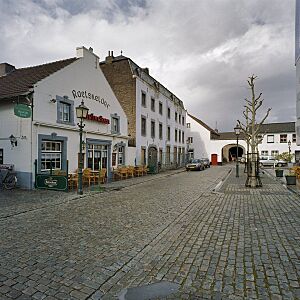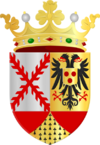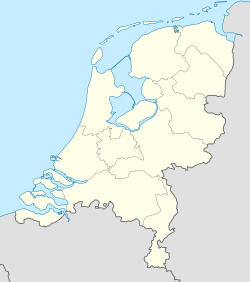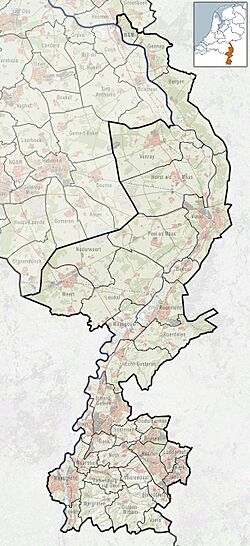Eijsden facts for kids
Quick facts for kids
Eijsden
Èèsjde (Limburgish)
|
|||
|---|---|---|---|

View on Eijsden
|
|||
|
|||
| Country | Netherlands | ||
| Province | Limburg (Netherlands) | ||
| Municipality | Eijsden-Margraten | ||
| Area | |||
| • Total | 3.69 km2 (1.42 sq mi) | ||
| Elevation | 56 m (184 ft) | ||
| Population | |||
| • Total | 4,255 | ||
| • Density | 1,153.1/km2 (2,987/sq mi) | ||
| Time zone | UTC+1 (CET) | ||
| • Summer (DST) | UTC+2 (CEST) | ||
| Postal code |
6245
|
||
| Dialing code | 043 | ||
Eijsden is a charming village located in the very south of the Netherlands, a country in Europe. You can find it in the southwestern part of the Limburg province.
Until 2011, Eijsden was the main village of its own municipality. But on January 1, 2011, it joined with the nearby municipality of Margraten. Now, they form the Eijsden-Margraten municipality, where Eijsden is still the largest place.
This village is one of the most southerly spots in the Netherlands. Its southern edge touches the border between the Netherlands and Belgium. The Meuse river, which flows from France and Belgium, enters the Netherlands right here. From this point, it's called the Maas in Dutch. The river flows north along Eijsden's west side, forming the border with Belgium.
A smaller stream called the Voer also flows from Belgium and joins the Meuse river in Eijsden.
Contents
Discovering Eijsden's Past
Eijsden is a very old place in the Netherlands. People believe its name comes from an old Germanic word for "aspen forest." Digs have shown that a Roman settlement once existed here. Over time, this settlement grew into a village during the Middle Ages.
After the Middle Ages, in the 1600s, Eijsden became economically stronger. This was because of its location near the Dutch-Belgian border on the Meuse river. Being a center for trade and shipping attracted wealthy merchants from Holland. This time of growth ended when the area was no longer a border region during the Napoleonic era.
Eijsden's Different Parts
The Eijsden area in the Eijsden-Margraten municipality is made up of several neighborhoods. Most of these areas are somewhat separate and have their own unique history.
- Breust is the northernmost part of Eijsden. It used to be its own municipality. Now, it's part of Eijsden and includes some newer housing areas.
- Mariadorp is located to the east of Eijsden's main village area.
- Laag-Caestert, Hoog-Caestert, and Withuis form the southern part of Eijsden. Hoog-Caestert is east of Laag-Caestert. Withuis is east of Hoog-Caestert, and part of it even crosses the border into Belgium!
Eijsden's Economy and Jobs
For a long time, Eijsden's economy was mostly about farming, especially growing fruit. At one point, Eijsden had the largest area of fruit trees in the Netherlands!
However, in the second half of the 1900s, many fruit orchards were replaced. People built houses, started dairy farms, and even opened factories. In 1870, a factory that made zinc white opened in Eijsden. This brought many jobs, but also some smoke into the air. The factory once employed about 700 people, and today, around 300 jobs are still there.
Because many new houses have been built, especially in the northern part, Eijsden is now mostly a place where people live.
Cool Places to See in Eijsden
Eijsden has some interesting historical places to visit:
- The beautiful 17th-century Renaissance-style Eijsden Castle is considered one of the top hundred buildings in the country.
- A stylish former monastery now houses the Museum het Ursulinenconvent. This is an International Museum for Family History.
- The historic "Vroenhof" central square is a great place to explore.
- You can also see four old water mills on the Voer river.
- There are two centuries-old church buildings that are worth a look.
Music in Eijsden
Eijsden is famous for its music, especially its two military bands! They are often called 'the blue' and 'the red'. The 'blue' band competes in the second-highest international division. The 'red' band competes in the highest division.
In 2009 and 2013, the 'red' band, officially called the Koninklijke Harmonie Sainte Cécile, won the World Concert Division. This was at the World Music Contest, a big competition for bands held in Kerkrade. The 'blue' band, the "Koninklijke Oude Harmonie Sainte Cécile," came in second place in the First Concert Division.
Famous People from Eijsden
Some well-known people were born in Eijsden:
- Jo Bonfrère, a famous footballer.
- Eugène Dubois, an anatomist and anthropologist.
- Jo Maas, a former cyclist who won a stage and finished seventh in the 1978 Tour de France.
- Jacques Vriends, a Dutch writer of children's books.
Gallery
-
The Meuse river entering the Netherlands at Eijsden.









